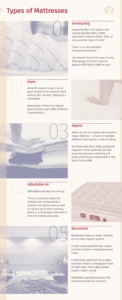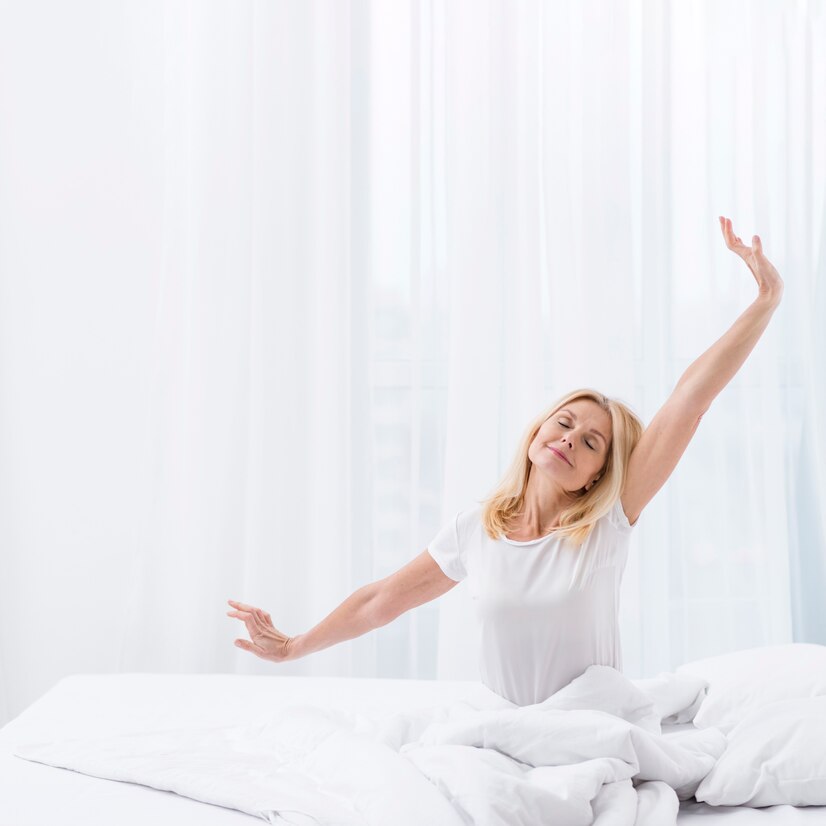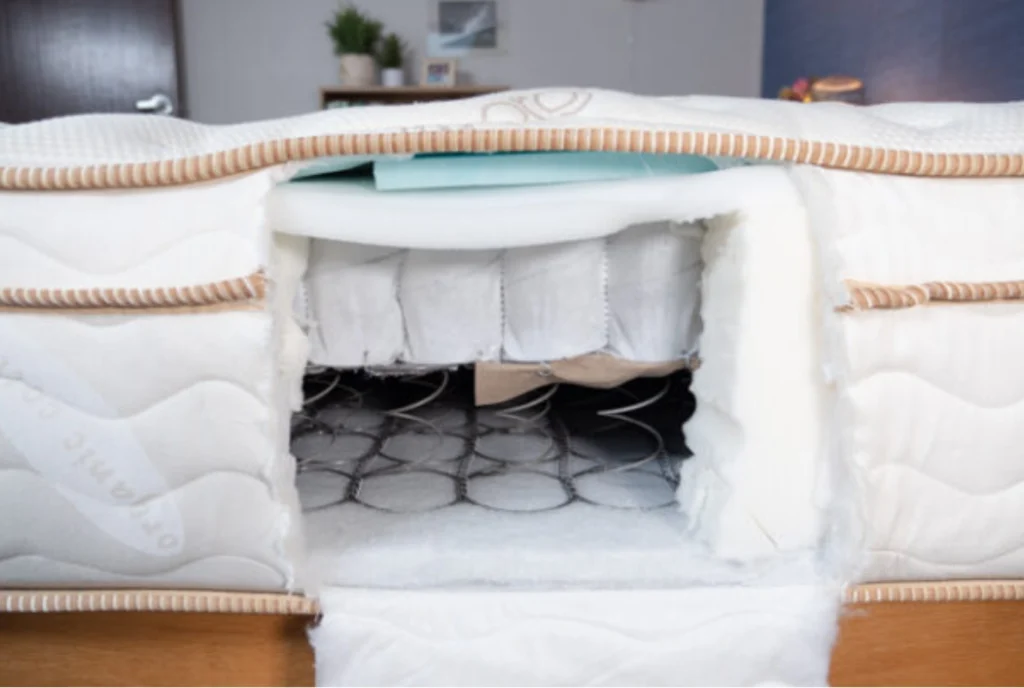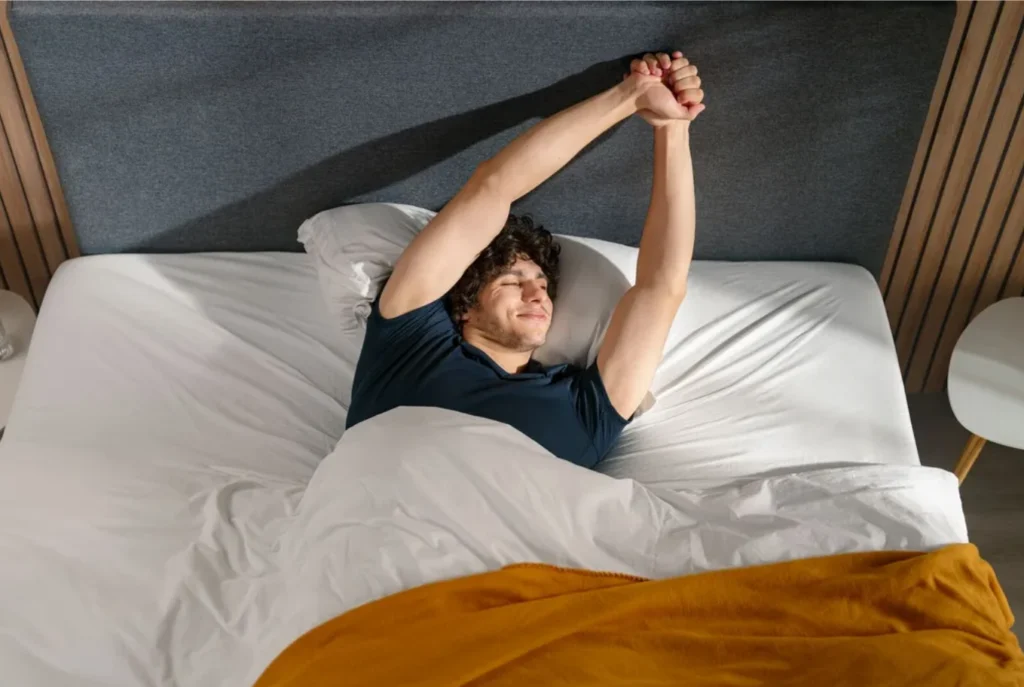One of the first big decisions when mattress shopping? Picking the type of mattress that suits you best. With so many options available, it helps to know the basics—what each type offers, how it feels, and who it’s best for. Here’s a guide to help you sort it all out.

🌀 Innerspring Mattresses
When most people think “mattress,” they’re picturing an innerspring. These classics use a system of metal coils for support, topped with upholstery like foam or fiber. They’re known for bounce and breathability and still make up the bulk of mattress sales.
Not all innersprings are created equal, though. Here’s what to look at:
Types of Coils
-
Bonnell Coils: Hourglass-shaped and commonly used. Good durability and support.
-
Offset Coils: Similar to Bonnell but with squared edges for a quieter, more solid feel.
-
Pocketed Coils (a.k.a. Marshall Coils): Each coil is wrapped in fabric—great for motion isolation and body contouring.
-
Continuous Wire: Coils made from one continuous piece of wire—durable and ideal for back support.
Coil Gauge & Count
-
Gauge: Thicker coils = lower numbers (12 = firmer, 15 = softer).
-
Count: More coils can mean more support, but type and gauge matter too. Don’t rely on numbers alone.
Flipping & Rotating
-
Some innerspring mattresses are double-sided (flip-able), while others are one-sided (rotate only). Always check the manufacturer’s instructions.
☁️ Foam Mattresses
Foam beds have exploded in popularity thanks to their pressure relief and motion isolation. No springs here—just layers of specialized foam designed for comfort and support.
Memory Foam
Made from viscoelastic foam, memory foam contours to your body for serious pressure relief. It’s a favorite for those with back pain.
-
Density Levels:
-
Low (under 3.5 lb/ft³) – Soft, less durable
-
Medium (3.5–5 lb/ft³) – Balanced
-
High (5+ lb/ft³) – Supportive, durable (and usually more expensive)
-
Keep in mind: Density ≠ firmness. A high-density foam can still feel soft!
Latex Foam
A more breathable and responsive alternative to memory foam. It doesn’t retain heat and doesn’t have that “sinking” feeling.
-
Two types:
-
Dunlop: Dense and supportive
-
Talalay: Softer, with more give
-
Natural latex is also antimicrobial and eco-friendly, but can be pricier.
Gel-Infused Foam
Designed to help regulate temperature, gel foam aims to offset the heat retention of traditional memory foam. Performance varies by brand, so ask how the gel is integrated.
Proprietary Foams
Many brands use their own signature foam blends with custom features. These vary a lot, so always ask for details on feel, breathability, and support.
🔄 Hybrid Mattresses
Hybrids combine the best of both worlds: a coil base for bounce and airflow, topped with foam layers for comfort and contouring. Great for those who want support without sacrificing softness.
🌿 Natural Materials
If you’re into eco-friendly living, natural mattresses made from wool, organic cotton, or natural latex may appeal to you. These beds avoid synthetic foams and harsh chemicals, though they typically come at a higher price point.
Natural latex in particular is a popular choice—it’s breathable, durable, and resistant to dust mites, mold, and bacteria.
💨 Adjustable Air Beds
These aren’t your average blow-up mattresses. Adjustable air beds like Sleep Number use internal air chambers to customize firmness at the push of a button. Many models include foam or fiber layers for added comfort and support.
💧 Waterbeds
Yep, they’re still around! Waterbeds use water chambers for support and come in either:
-
Hard-sided (wooden frame)
-
Soft-sided (foam encased in fabric)
They’ve evolved a lot since the ‘80s but still offer that unique floating feel.
📱 Smart Mattresses
Welcome to the future of sleep. Smart mattresses look and feel like traditional beds but include built-in tech like sleep tracking, temperature regulation, and even automatic firmness adjustments.
Some sync with your smartphone to provide sleep data and insights—great if you’re serious about improving sleep habits.
🛏 Mattress Tops
The type of top your mattress has can change how it feels, even if the core materials are the same.
-
Pillow-top: Soft, plush layer sewn on top for added cushioning.
-
Euro-top/Box-top: Like a pillow-top but denser and flush with the mattress edge.
-
Tight-top: No extra padding—feels firmer and more uniform.
💤 Sleep Position & Comfort Levels
Your sleep position plays a big role in choosing the right mattress firmness:
-
Back Sleepers: Medium to medium-firm (around 6.5–7/10) usually feels best.
-
Stomach Sleepers: Go for firmer support to prevent lower back sagging.
-
Side Sleepers: Softer, plusher beds relieve pressure on hips and shoulders.
-
Combination Sleepers: Look for a balanced feel—one that adapts to multiple positions.
Firmness is often rated on a scale of 1 (soft) to 10 (firm), but be aware: comfort is subjective!
🌟 Special Considerations
Everyone has different sleep needs. Here are a few extras to think about:
-
Hot Sleeper? Look for breathable materials like coils, latex, or gel-infused foams.
-
Injuries or Chronic Pain? Supportive foam layers can help relieve pressure and improve spinal alignment.
-
Pregnant? A soft, supportive bed or topper can relieve pressure while side-sleeping.
-
Medical Needs? Hospital-grade adjustable beds may be best—talk to your doctor before choosing.



